Chapter 11 Biology Class 11 Notes - FREE PDF Download
Photosynthesis In Higher Plants Class 11 Notes PDF Download is prepared to enhance your study experience with clear and concise explanations. These notes simplify complex concepts into easy-to-understand points, covering all the critical aspects of photosynthesis. Students can explore the process of how plants convert light energy into chemical energy, the role of chlorophyll, and the significance of different stages like light-dependent reactions and the Calvin cycle. Vedantu provides Class 11 Biology Revision notes that are prepared to provide quick summaries and highlight essential points, helping you grasp the concepts efficiently.
Download the FREE PDF for Chapter 11 Biology Class 11 Notes, prepared by experts at Vedantu and updated according to the latest CBSE Class 11 Biology Syllabus, to make study sessions more productive and efficient.






Access Revision Notes for Class 11 Biology Chapter 11 - Photosynthesis in Higher Plants
Photosynthesis is the process by which green plants, algae, and some bacteria convert light energy into chemical energy. During photosynthesis, these organisms use sunlight to transform carbon dioxide and water into glucose (a type of sugar) and oxygen. In simple words, The process of synthesising organic food (carbohydrates) using carbon dioxide and water in the presence of sunlight is called photosynthesis.
All green plants have the ability to produce food through photosynthesis. This is the most important process of synthesis on Earth because it is the only carbohydrate source in which solar energy is converted into chemical energy. In the process of photosynthesis, the kinetic energy (light energy) of sunlight is converted into chemical energy and stored in carbohydrate molecules. This chemical energy is used to grow and maintain our biosphere. All animals, including humans, depend on plants directly or indirectly for their food.
11.1 What We Know About Photosynthesis:
Photosynthesis is a natural physicochemical process, on which the existence of life on the planet Earth depends. This photosynthesis is the most important biological process necessary for human existence. Chlorophyll, light and carbon dioxide are major requirements for photosynthesis Below are some experiments to test this.
1. Variegated Leaf Experiment:
A variegated or deformed leaf is exposed to sunlight and then checked for starch. In testing, it was evident that the white spots appear colorless because they lack chlorophyll. Based on this, we assumed that chlorophyll is required for photosynthesis to take place.
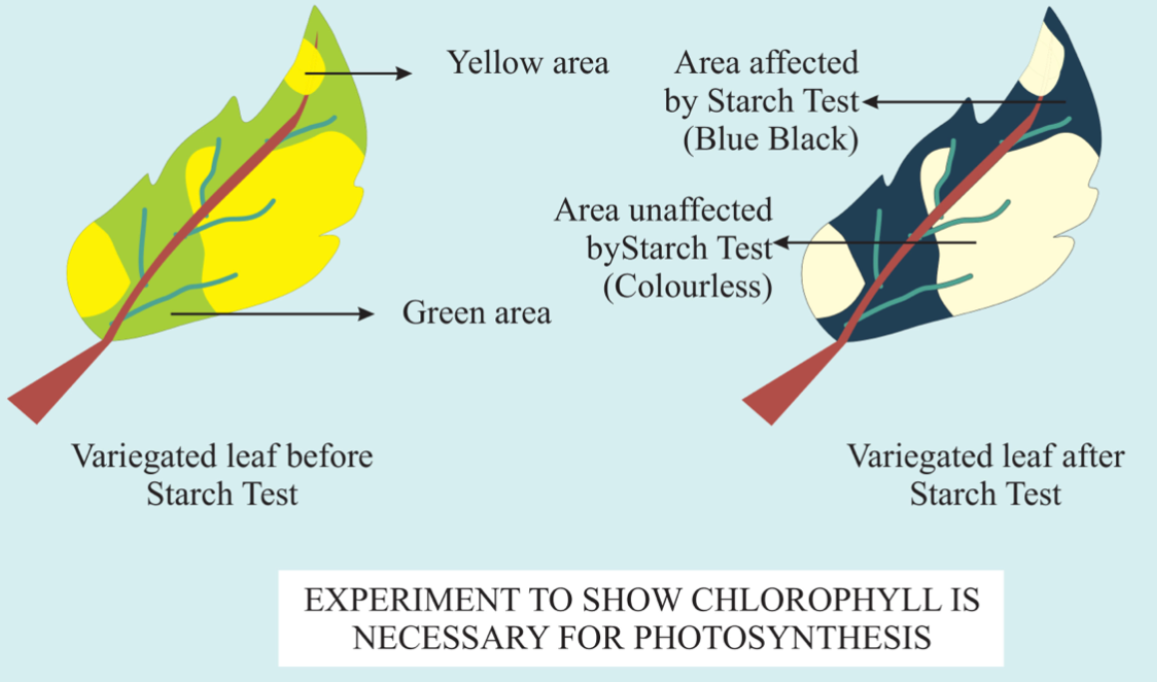
2. Light Screen Experiment:
A light screen experiment was used to demonstrate that light is needed for photosynthesis. Then starved plants that were potted, were taken. Then a Ganong's light shade or black paper is attached to one of the leaves of the starved plant. The Ganong's light screen is a motion-transmitting device in which the free air only allows light to pass through a limited area. The plant is now exposed to sunlight for several hours. Then the leaf is removed and the starch is analyzed. The starchy area turns blue, while the non-starchy area remains colourless. In addition, only leaves exposed to sunlight turn blue. The sunlight-exposed leaf part showed positive results for the synthesis of carbohydrates. The covered part, cut off from sunlight, does not produce carbohydrates. Based on this, we assume that sunlight is required for photosynthesis.
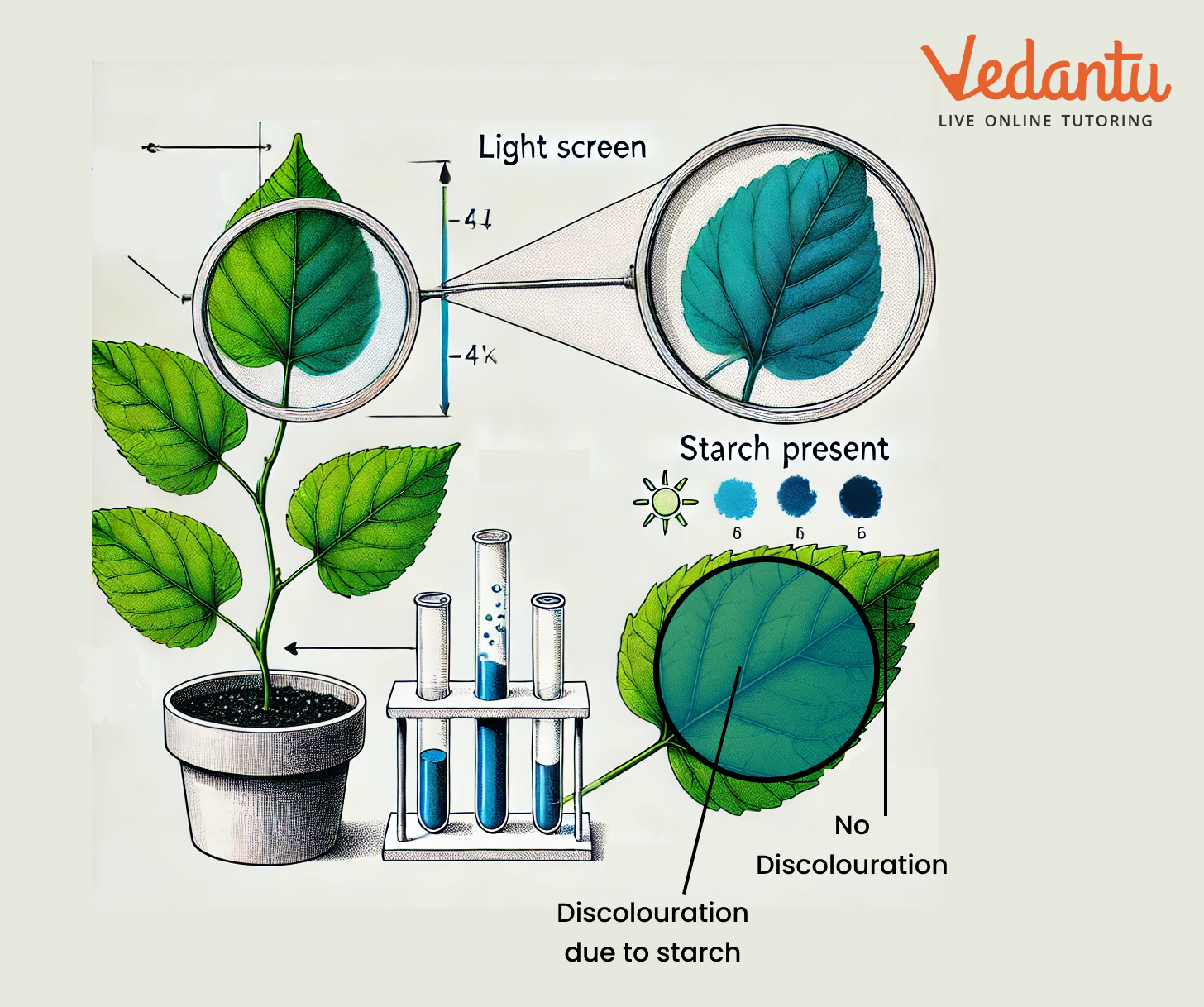
3. Mohl's Experiment:
Mohl's experiment was used to demonstrate that carbon dioxide is required for photosynthesis. Half of the starved leaves are passed through a cork, divided in half and placed in a jar having cotton soaked in a small amount of potassium hydroxide. The other half of the leaf is in the air. The leaf is then soaked in a bowl containing water. The whole setup is kept under sunlight for a while, and then the starch is analyzed. It can be seen that starch is formed only on the outer leaf parts of the bottle, while the leaves inside the bottle do not show the presence of starch. The leaves outside the vase meet all the requirements for photosynthesis. Because potassium hydroxide absorbs carbon dioxide, no starch forms on the leaves inside the bottle, indicating that carbon dioxide is essential for photosynthesis.
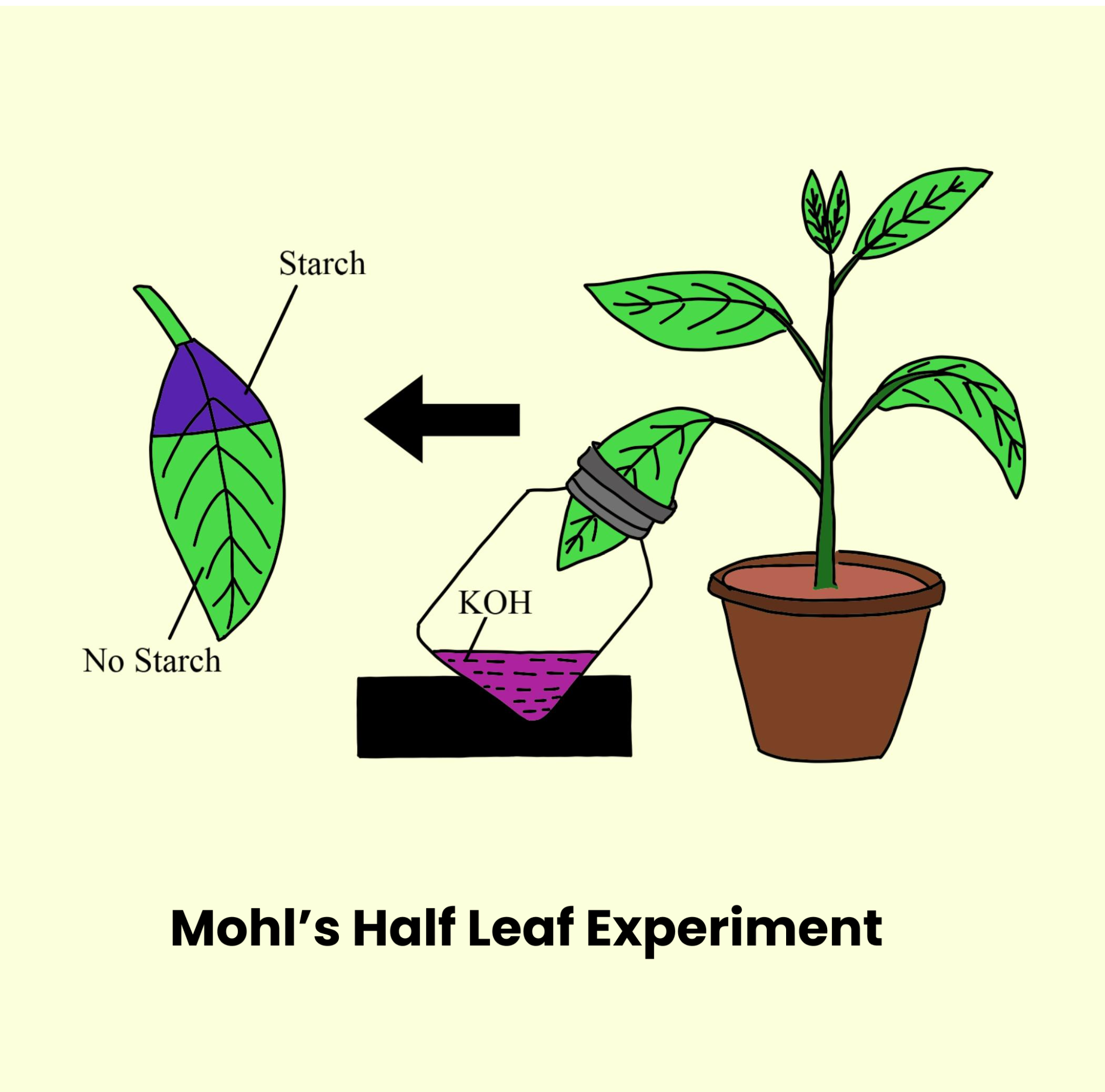
11.2 Early Experiments Based on Photosynthesis:
Joseph Priestley demonstrated in 1774 that plants have the ability to absorb carbon dioxide from the atmosphere and release oxygen. He conducted an experiment: he took a glass bell-shaped jar and placed a rat and a lighted candle in it. He noticed that the air inside had changed, he did not allow the rat to live in it. Then he placed the mint in a container of water inside the same jar, while he watched the rat living inside with a lit candle. From this, he concluded that this vegetation cleared the air polluted by the flame. Based on this experiment, Priestley suggested that plants return air to what animals breathe, and candles remove it.
He named the air generated by burning candles PHLOGISTON, which is harmful to rats, and says that the plants turn it into DEPHLOGISTON.
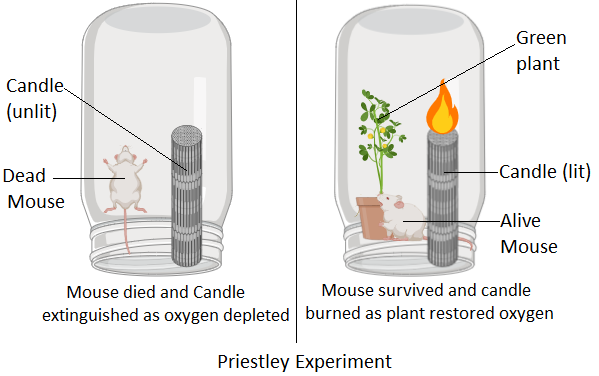
Jan Ingenhousz says that green leaves give off dephlogisticated air (air rich in oxygen) in the presence of sunlight, while in the absence of sunlight (in darkness) they give off phlogisticated air (air rich in carbon dioxide) and make the air unclean.
Julius von Sachs discovered in 1854 that green plants synthesize glucose and are usually stored as starch.
TW Engelmann worked with Cladophora and Spirogyra and noticed that when the light was split by a prism and used to illuminate the algae, the organisms clustered in blue and red light zones.
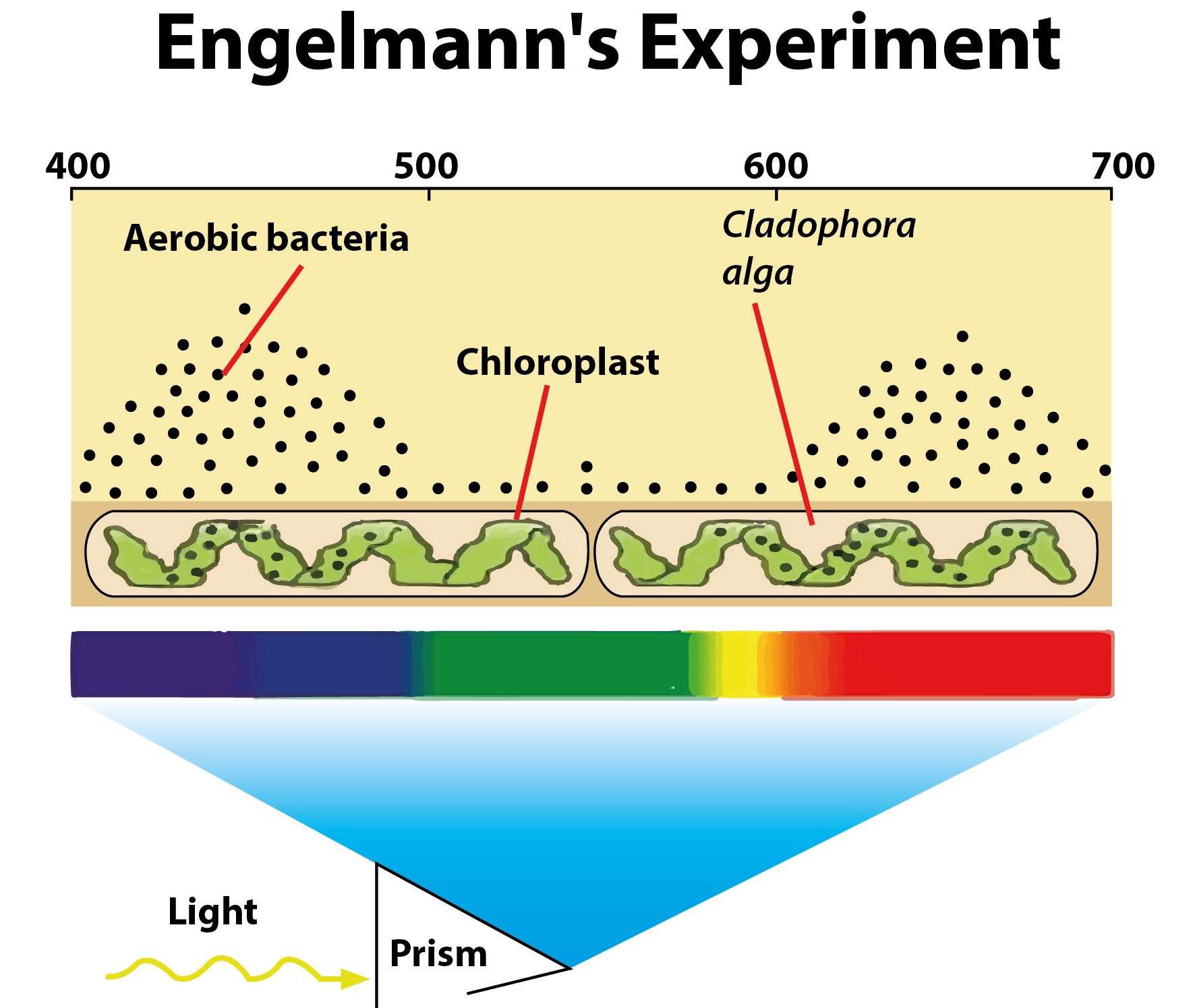
Cornelius van Niel experimented with green and purple sulfur bacteria. He tried to prove that hydrogen is released from suitable oxidizable compounds that reduce carbon dioxide to carbohydrates which also suggests that water is a source of oxygen during photosynthesis.
The Sulphur gas released was from H2S Van Neil gave a simplified equation of photosynthesis as given below
The oxygen released in the above equation is from H2O and not from CO2.
11.3 Where Does Photosynthesis Take Place?
Chloroplast is a semiautonomous and endosymbiont cell organelle with three membrane systems present in the cells of green plants. It consists of three main parts: an envelope, a matrix, and a thylakoid.
Envelope: It consists of an outer membrane and an inner membrane. The space between the outer and inner membranes is called periplasmic space.
Matrix: A semi-liquid substrate is called a matrix that contains double-stranded circular DNA,70S ribosome, RUBISCO carboxylation enzyme and PEP carboxylase enzyme, Mg, CI, Mn, etc.
Thylakoid: It is a flattened membrane-covered sac-like structure that joins together to form a granum. Each thylakoid present in granum is called a granum thylakoid that contains a lumen for photolysis of water by Mg, Mn, Cl, Ca and various electron carriers. Grana are connected with each other by stroma lamellae and the space within it is called the fret channel. The thylakoid membrane has 200 to 400 pigment molecules associated with certain proteins called CAB, collectively known as quantosomes or light-harvesting complexes. Thylakoid membranes also have F0-F1 or coupling factor and the number of electronic carriers located depends on their redox potential.
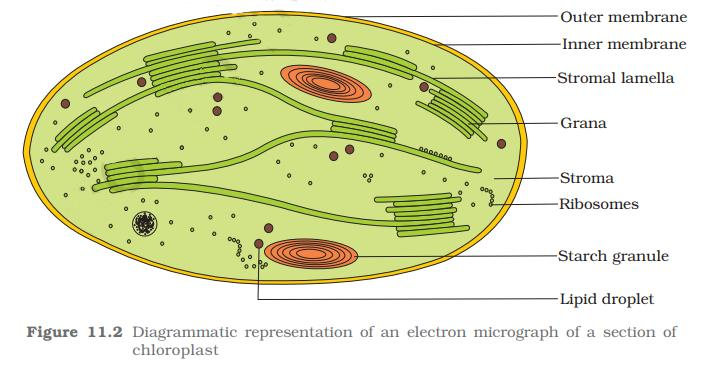
11.4 Pigments Involved in Photosynthesis:
Photosynthetic unit (PSU)/Light-Harvesting Complex (LHC)/Quantasome:
The quantasomes are considered units of photosynthesis and were recognized by Roderick B. Park. They are composed of lipids and proteins and are located in the thylakoid membrane of the chloroplast.
This is the smallest group of pigment molecules involved in the conversion of light into chemical energy.
They have a reaction centre/photo centre/trap centre, which is always a single chlorophyll molecule that feeds on light-harvesting pigments.
They are made up of:
Core Molecule: The core molecule comprises 20-30 chlorophyll A molecules present around the reaction centre.
Antenna Molecules: They are present around core molecules. They absorb light at shorter wavelengths. When they absorb light, they are excited and pass energy to the core, which then passes to reaction centres with the help of electron spin resonance reaction.
There are two light systems PS I and PS II. LHC consists of hundreds of pigment molecules bound to proteins.
Each PS has all the pigment molecules associated with a protein.
Each PS contains all the pigments except one chlorophyll molecule, which forms the LH system, also known as the antenna.
Chlorophyll alone acts as a reaction centre that is different in both photosystems. P700 is the reaction centre in PS I and P680 is the reaction centre in PS II.
Light Harvesting Complex:
200-400 pigments + protein (CAB)
RC+ Core molecule + Antenna + protein
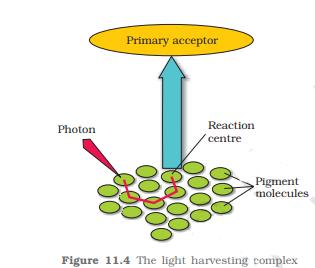
Photosynthetic Pigments:
Three main types of photosynthetic pigments are as follows:
I. Chlorophylls
II. Carotenoids
III. Phycobilins
I. Chlorophyll:
The term was coined by Pierre Joseph Pelletier and Joseph Bienaimé Caventou.
These are various types of green water-soluble pigments.
Following are the types of chlorophyll pigment:
Chlorophyll | Descriptions |
Chlorophyll-a |
|
Chlorophyll-b |
|
Chlorophyll-d |
|
Chlorophyll-e |
|
Bacteriochlorophyll |
|
Chlorobium chlorophyll |
|
ll. Carotenoids:
Also called sheil pigments they protect chlorophyll from photooxidation.
They are water-insoluble accessory pigments which are yellow-orange in colour.
Light is not required for their production. They absorb blue and violet light.
They are triterpenes in general.
There are two types of carotenoids which are carotenes and xanthophylls.
Carotenes are reduced molecules with molecular formula C40 H56. They are of three types which are Alpha, Beta and Gamma carotene.
Alpha carotene is present in all types of plants.
Beta carotene is a precursor of Vitamin-A and present abundantly.
Gamma carotene is found in green sulphur bacteria.
Xanthophylls are oxygen-containing derivatives of carotene and are yellow-brown in colour. It is found abundantly in Viola.
Fucoxanthin is present in brown algae that is responsible for its brown colour.
Lycopene is the red pigment found in tomato and chilly.
III. Phycobilins:
These are the photosynthetic pigments of an algal group which is structurally related to bile pigments having open tetrapyrrole with neither Mg nor phytol tail.
They are only soluble in water and are of three types which are Phycoerythrin, Phycocyanin, and Allophycocyanin.
They are important accessory pigments found in both blue-green algae and red algae and are also known as biliproteins.
Absorption Spectrum
Chloroplast pigments are responsible for absorbing light.
A certain pigment absorbs light rays of different wavelengths.
For example, chlorophyll-a absorbs blue and red light in the visible spectrum. The amount of light absorbed by a pigment can be represented graphically.
The absorption spectrum (peak) relative to the wavelength is called the absorption spectrum.
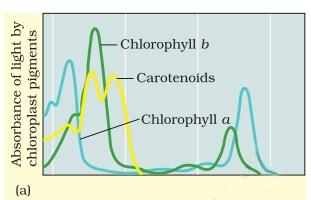
Action Spectrum
Photosynthesis occurs in visible light with wavelengths of 400 to 700 nm.
It does not occur at the same rate as other wavelengths.
The rate of photosynthesis at different wavelengths is measured and expressed as the degree of activity. (i.e. oxygen evolution using carbon dioxide). This graphical representation of the rate of photosynthesis as a function of wavelength is called the spectrum of activity.
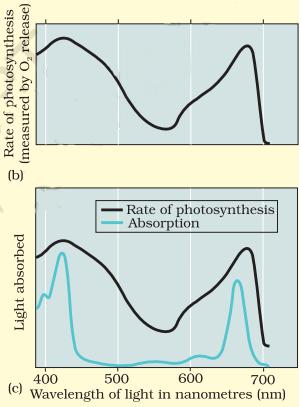
11.5 Light Reaction
TW Engelmann constructed the first spectrum of photosynthesis activity using the green algae Cladophora in 1882.
The maximum rate of photosynthesis occurs with red light in the visible spectrum. Photosynthesis mostly occurs in the blue and red regions of the visible spectrum but it does not occur at the same rate at other wavelengths of the spectrum, which is because the accessory pigments are only capable of absorbing light energy and transferring it to chlorophyll-a.
The light reaction occurs only in chlorophyll-a (reaction center). Mechanism of photosynthesis: Photosynthesis is a redox reaction in which water is oxidized and carbon dioxide is reduced.
The general equation of photosynthesis can be written as
The end products of photosynthesis are carbohydrates, water and oxygen whereas carbon dioxide and water are the raw materials for photosynthesis. Oxygen is released in the atmosphere as a by-product of this process. In photosynthesis reactions, oxygen comes from water, not from carbon dioxide. In photosynthetic plants, water is the donor of hydrogen, as well as a source of oxygen released.
In 1932, Robert Emerson and Arnold proposed that the entire process of photosynthesis consists of two distinct stages: the photosynthetic phase and the biosynthetic phase.
Photochemical Phase or Light Reaction: This is the light-dependent stage of photosynthesis, in which ATP and NADPH are formed in the presence of sunlight.
This occurs in the chloroplast grana in the presence of sunlight. It includes the following steps:
Light absorption
Splitting of Water
Release of oxygen.
Formation of high-energy chemical intermediates (ATP and NADPH)
In 1935, Robert Emerson showed that two pigment systems are present in the light reaction. These are Pigment System I (Photosystem I and PS I) and Pigment System II (PS II).
Both Reaction Center and Light-harvesting System (accessory pigments) together make a photosystem or pigment system. Approximately 250 to 450 pigment molecules make up a single photosystem.
Photosystems are functional and structural units having protein complexes involved in photosynthesis. They are present in the thylakoid membranes of plants and algae or in the cytoplasmic membranes of photosynthetic bacteria. There are two types of photosystems: Photosystem I and Photosystem II. Both of them are required for oxygenic photosynthesis. Photosystem II is located in the pinched area of the granal thylakoids. PS I was found in the underdeveloped region of the thylakoid of grana and stroma.
11.6 Electron Transport
Non-Cyclic Photophosphorylation: It is also referred to as Z-scheme. It consists both PS I and PS II. Photosystem (PS II) consists of Chlorophyll-a 660, Chlorophylla 673, Chlorophyll-a 690, Chlorophyll-b, Chlorophyll-c, or Chlorophyll-d, carotenoids, and phycobilins. The reaction centre is chlorophyll-a 680.
It takes place in stromal lamellae. The electron does not return to the reaction center, but NADP+ accepts it. Electrons are used during the photolysis of water and lead to the formation of ATP and NADPH2.
The process steps begin with PS II.
Electrons are transferred to the plastoquinone reductant (PQRS).
PQRS passes them to plastoquinone which then transfers them to the cytochrome system.
The cytochrome system transfers them to plastocyanin, which then transfers them to PS I.
The next steps included FRS, ferredoxin, and NADP reductase molecules. Cyclic electron flow
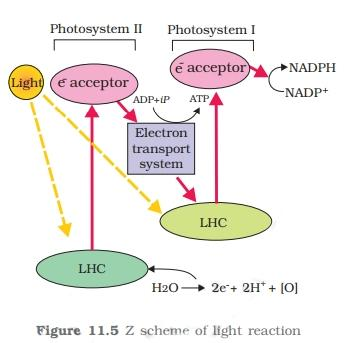
11.6.1 Photolysis of Water:
P680 becomes a strong oxidant and breaks down the water molecule to generate oxygen. This light-dependent fission of water molecules is called the photolysis of water.
Ions of manganese, calcium and chlorine play an important role in the photolysis of water.
The photolysis of water during photosynthesis was first demonstrated by Robert Hill in 1937.
Water breaks down into hydrogen ions, oxygen and electrons. Oxygen is one of the end products of the photosynthesis process.
11.6.2 Cyclic and Non-Cyclic Photophosphorylation:
This step is also known as light reaction / Hill reaction / photochemical reaction/photophase.
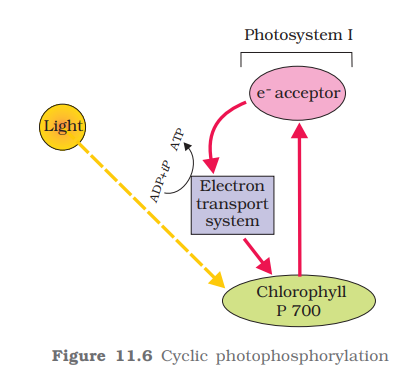
Comparison of Cyclic and Non-Cyclic Photophosphorylation:
Feature | Cyclic Photophosphorylation | Non-Cyclic Photophosphorylation |
Photosystems Involved | Only Photosystem I (PSI) | Photosystem I (PSI) and Photosystem II (PSII) |
Electron Flow | Electrons are recycled back to PSI | Electrons flow from PSII to PSI, then to NADP+ |
Products | ATP | ATP, NADPH, and Oxygen |
Oxygen Production | No oxygen is produced | Oxygen is produced as a by-product |
Purpose | Mainly to produce ATP when ATP demand is high | Provides both ATP and NADPH for the Calvin cycle |
Water Splitting | Not involved | Involves splitting of water to release oxygen |
11.6.3 Chemiosmotic Hypothesis:
The chemiosmotic hypothesis explains the ATP synthesis in chloroplasts. It was proposed in 1961 by Peter Mitchell.
According to this hypothesis, a proton gradient develops across the thylakoid membrane during photosynthesis. Protons accumulate in the thylakoid membrane in the thylakoid lumen.
The proton gradient is induced in 3 ways:
Water molecules decompose into H+ and OH- on the inner surface of the thylakoid membrane. As a result, H+ accumulates in the thylakoid lumen.
When electrons move through photosystem I and photosystem II, H+ is passed across the thylakoid membrane. The main electron acceptor is located on the outside of the thylakoid membrane. This primary electron acceptor transfers its electrons to the carrier H, not directly to the carrier of electrons. This hydrogen-carrying molecule carries electrons to electron carriers (cytochrome-b, cytochrome-f, etc.) on the inner surface of the thylakoid membrane and removes an H+ion from the stroma while passing electrons. This proton is released on the inner surface of the thylakoid membrane.
The enzyme NADP-reductase is located on the stromal side of the thylakoid membrane. When electrons come from the electron acceptor PS I, H+ions are required to reduce NADP+ to NADPH and H+. These H+ions are removed from the stroma.
Thus, in the chloroplast, H+ ions accumulate in the thylakoid lumen and decrease in quantity in the stroma.
This induces a proton gradient across the thylakoid membrane, resulting in a decrease in PH in the thylakoid lumen.
The proton gradient is disrupted when the proton moves the stroma through the F0 transmembrane channel of the ATPase enzyme across the thylakoid membrane.
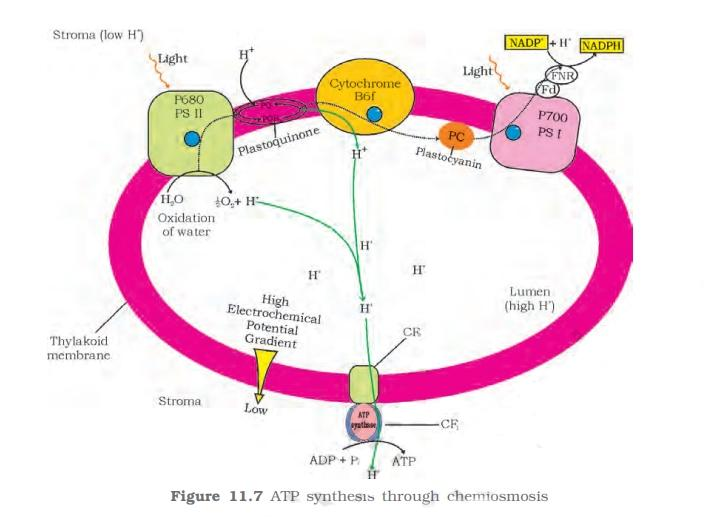
Enzyme ATPase consists of two parts: the base of the ATPase is called F0, and the head is called F1.
F0 forms a transmembrane channel embedded in the thylakoid membrane on the opposite side of the stroma.
The chemiosmosis process requires a membrane, a proton pump, a proton gradient, and an ATPase enzyme.
The ATPase F0 channel provides reverse diffusion of H+ across the thylakoid membrane. As a result, enough energy is released. This energy activates A TPase.
ATPase catalyzes the synthesis of ATP from ADP. This ATP is used immediately in the dark of the reaction taking place in the stroma. As a result, sugar synthesis is carried out by fixing carbon dioxide.
11.7 Where are ATP and NADPH Used?
Biosynthetic Phase: This phase is also known by other names like Calvin cycle, C3 cycle, Photosynthetic Carbon Reduction cycle, and Reductive pentose pathway.
The C3 cycle is a part of the dark reaction since direct light is not required for this to take place.
Calvin presented these reactions in a cyclic fashion, which is why it is called the Calvin cycle.
A tri-carbon compound known as phosphoglyceric acid (PGA) was the first stable compound created in the Calvin cycle. Thus, this cycle is also known as the C3 cycle.
Calvin uses Chlorella pyrenoidosa as an experimental organism. Chlorella is a single-celled green alga. This alga contains cup-shaped chloroplasts, which carry out photosynthesis, similar to higher plants.
The radioactive carbon dioxide containing the radioactive isotope carbon(C- 14) was used in this experiment.
He also used chromatography and autoradiography techniques in his experiments.
ATP and NADPH, formed during the reaction with light in the chloroplast, are necessary for the assimilation of carbon dioxide into carbohydrates.
All enzymes necessary for the assimilation of carbon dioxide are present in the stroma. The dark reaction or C3 pathway occurs in chloroplast's stroma.
11.7.1 The Primary Acceptor of CO2:
RuBP (Ribulose 1,5-bisphosphate) is the primary acceptor of carbon dioxide. It is a 5-carbon containing compound.
11.7.2 The Calvin Cycle:
The Calvin cycle is divided into 3 different stages which are:
Carboxylation: It is the step in which carbon dioxide combines with RuBP.
Reduction: It is the step in which carbohydrates are formed using photochemically made ATP and NADPH.
Regeneration: In this step, a carbon dioxide acceptor (RuBP) is formed again so that the cycle continues.
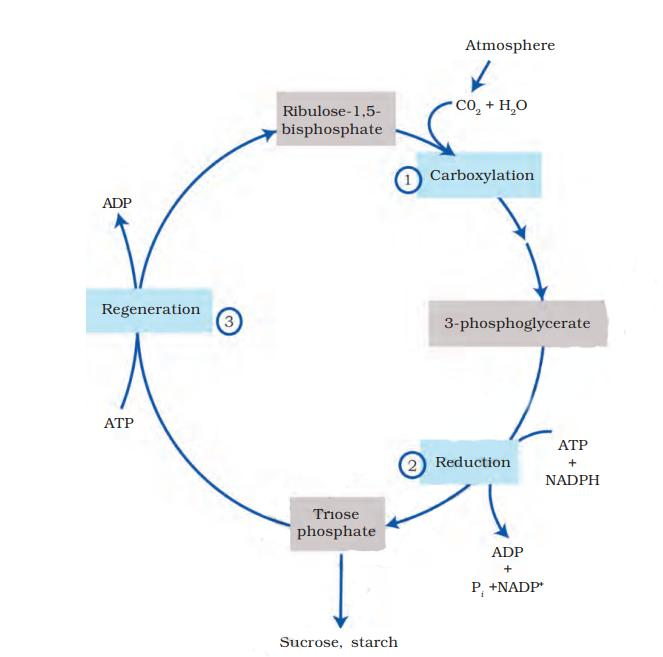
I. Carboxylation: The binding of carbon dioxide to a stable intermediate is called carboxylation.
The real 5-carbon compound, ribulose bisphosphate (RuBP), accepts carbon dioxide.
Six RuBP molecules combine with six carbon dioxide molecules to form six molecules of 6-carbon-containing compounds.
The resulting carbon compounds are unstable. Six molecules of these 6-carbon compounds immediately decompose into 12 molecules of 3-phosphoglyceric acid (PGA) in the presence of water.
PGA is a 3-carbon compound and was the first stable compound produced during photosynthesis.
The carboxylation reaction is catalyzed by an enzyme called RuBisCo (RuBP carboxylase).
RuBisCo also has oxidative activity and is therefore abbreviated as RuBisCo (RuBP carboxylase ● oxygenase). The oxidative activity of the enzyme allows it to compete with carbon dioxide for binding to RuBP (photorespiration).
II. Reduction: The process of adding hydrogen is called reduction.
PGA is reduced to glyceraldehyde phosphate using anabolic energy, ATP and NADPH are formed in light reaction. Hydrogen from NADPH is added to this reaction.
PGAL is a 3-carbon sugar (triose sugar). Reconstructed ADP and NADP+ were used for additional light response. This stage obviously changes the stage of the glycolysis reaction. In this case, the reduced power is obtained at the expense of NADPH instead of NADH.
The 3-carbon molecule (PGAL) formed in the reduction reaction of the Calvin cycle is also known as phosphate triose. These triose phosphates (PGALs) act as precursors for the synthesis of sucrose and starch. III. Regeneration: Regeneration of the 12 glyceraldehyde phosphate (PGAL) molecules formed during the recovery phase.
Out of these 12 molecules, 10 were obtained with 6 ATP molecules through a complex series of reactions that regenerate ribulose bisphosphate (RuBP).
This reaction produces intermediates such as Erythrose mono phosphate, Xylulose monophosphate, Sedoheptulose mono phosphate, Ribose monophosphate and Ribulose monophosphate.
The 6 ATP used herein is also formed by photochemical reactions. For every 6 carbon dioxide molecules that enter the Calvin cycle, the net yield is 2 PGAL molecules.
It takes 6 cycles of the Calvin cycle to form one glucose molecule.
The C3 cycle requires 18 ATP to synthesize one glucose molecule. But out of 18 ATP, 6 ATP molecules are used to regenerate RuBP after the formation of a glucose molecule.
In the Calvin cycle, ADP and NADP+ are regenerated, which are necessary for the light reaction.
11.8 C4 Pathway:
It is also known as Hatch and Slack Pathway or Di carboxylic acid cycle or CO2 concentration mechanism.
Kortschak and Hatch first noticed that 4 C, oxaloacetic acid (OAA) is formed in sugarcane leaves during the dark reaction. Hatch and Slack suggest a dark reaction pathway in sugarcane and corn leaves.
This is the fixation of carbon dioxide in tropical plants such as corn, sugarcane, sorghum, millet, A maranthus, etc.
Hatch and Slack reported that the first acid formed was a 4-carbon compound called oxaloacetic acid.
It shows special blade anatomy known as Kranz anatomy in which the green bundle sheath cells are present around the vascular bundle.
There are two types of chloroplasts (dimorphic) in leaf cells. In the cells of the mesoderm, the chloroplasts are small and present with grana, while the chloroplasts of the membrane cells are larger without grana.
The enzyme PEPCase (phosphoenolpyruvate carboxylase) is present in the mesoderm cells, while RuBisCo is present in bundle sheath cells.
In C4 plants, the C3 cycle occurs in the cells of the bundle sheath, while the C4 cycle occurs in the mesophyll cells.
The phosphoenolpyruvate (PEP) is the acceptor of carbon dioxide in the C4 pathway and it is a compound of carbon 3.
The enzyme named PEPCase catalyzes the first carboxylation in the C4 cycle in the cytoplasm of mesophilic cells.
The second or final carboxylation occurs in the bundle sheath cells via the C3 cycle. 30 ATP molecules are required for the production of one glucose molecule in C4 plants.
The pyruvate to PEP conversion takes place by the enzyme pyruvate phosphate dikinase (PPDK), converting ATP to AMP. This PEP regeneration helps C4 plants to improve their carbon dioxide fixation efficiency.
The path begins with the conversion of pyruvate to phosphoenolpyruvate with the help of the enzyme pyruvate orthophosphate dikinase.
This is followed by the fixation of carbon dioxide in oxaloacetate by the enzyme PEP carboxylase. Both reactions take place in the cells of the mesoderm.
OAA converted to malate, is transported to the bundle sheath cells. Decarboxylation of malate gives carbon dioxide and pyruvate.
Carbon dioxide now enters the Calvin cycle and pyruvate is transported to the cells of the mesoderm.
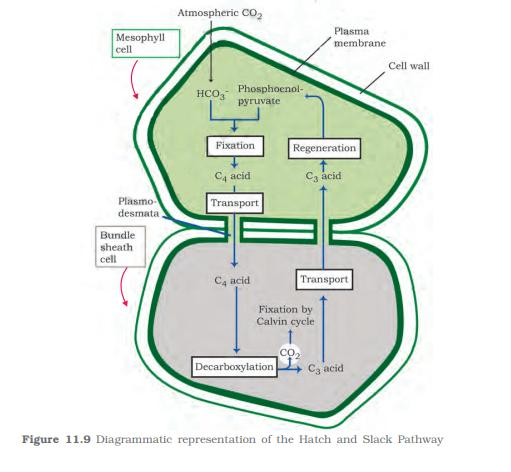
Advantages of C4 Pathway:
There is no photorespiration that occurs in the C4 pathway and is more efficient in picking carbon dioxide because PEP has more affinity to carbon dioxide.
The effect of water stress in C4 plants is minimized since the bundle sheath cells are located near the surface of the water supply.
It has organic acids, hence can tolerate stress.
C4 plants have strategies to minimize water loss by fixing the same amount of carbon dioxide.
C4 plants were twice as effective as C3 plants for the same amount of carbon dioxide fixation.
CAM pathway or Crassulacean acid metabolism or Dark acidification: It was first found in Bryophyllum from the Crassulaceae family.
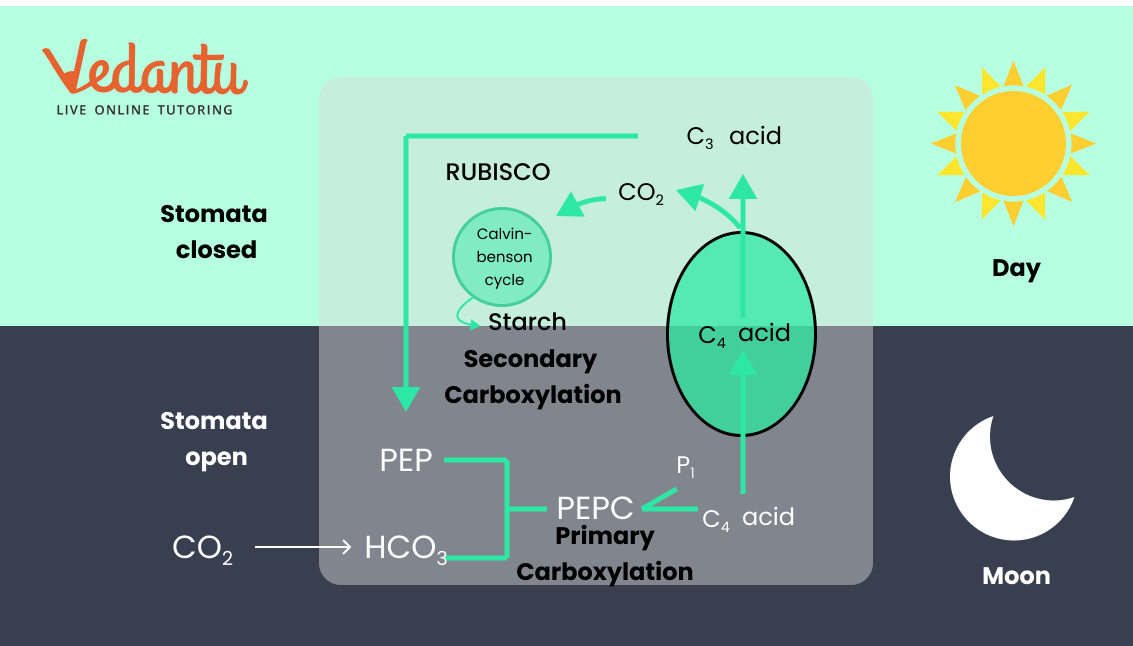
CAM is an adaptation for succulents such as Opuntia, Agave, Pineapple, Sedum, Kalanchoe, Kleinia, etc.
Phosphoenol pyruvate is the main carbon dioxide acceptor and oxaloacetic acid is the first product produced in the reaction.
CAM plants have scotoactive type stomata (open at night).
Organic acids are formed at night and decompose during the day, and the final fixation of carbon dioxide occurs during the day.
PEPCase induces carboxylation at night time. PEP carboxylase and RuBisCo, both are present in mesophyll cells.
30ATP were required for the synthesis of 1 glucose molecule, and Kranz's anatomy was not found.
CAM plants close their stomata during the day and significantly reduce water loss in the daytime.
Comparison of C3, C4, and CAM (Crassulacean Acid Metabolism) Cycles:
Feature | C3 Cycle | C4 Cycle | CAM Cycle |
Common Name | Calvin Cycle | Hatch-Slack Pathway | CAM Pathway |
Main Photosynthetic Pathway | Carbon fixation and reduction to glucose | Carbon fixation in a separate pathway | Carbon fixation at night |
Initial Carbon Fixation | CO₂ fixed to 3-phosphoglycerate (3-PGA) | CO₂ fixed to oxaloacetate (OAA), then malate | CO₂ fixed to oxaloacetate (OAA), then malate |
Key Enzyme | Rubisco | PEP carboxylase (PEPC) | PEP carboxylase (PEPC) |
Primary Location | Stroma of chloroplasts | Bundle sheath cells and mesophyll cells | Mesophyll cells |
Temperature Adaptation | Suited to moderate temperatures | Suited to high temperatures and high light intensities | Suited to arid conditions and drought |
Oxygen Sensitivity | Sensitive to oxygen (photorespiration) | Less sensitive to oxygen (photorespiration) | Less sensitive to oxygen (photorespiration) |
Efficiency of Carbon Fixation | Moderate efficiency | High efficiency in hot climates | High efficiency in dry conditions |
Energy Cost | Lower energy cost (only Calvin Cycle) | Higher energy cost (additional ATP for C4 pathway) | Higher energy cost (additional ATP for CAM pathway) |
Day/Night Cycle | Carbon fixation occurs during the day | Carbon fixation occurs during the day | Carbon fixation occurs at night (CO₂ uptake) and conversion during the day |
11.9 Photorespiration:
It is also known as the photosynthetic carbon oxidation cycle or C2 cycle or Glycolate metabolism.
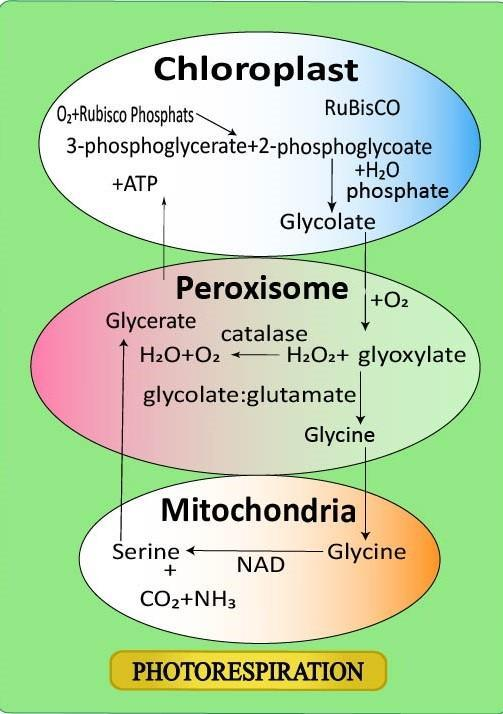
It is light-dependent oxygen consumption and carbon dioxide reduction by photosynthetic organs.
It occurs at high temperatures and large amounts of oxygen.
Under these conditions, the affinity of RuBP for oxygen increases, while carbon dioxide decreases.
Photorespiration does not produce energy and can reduce photosynthesis by up to 50%. But in C4 plants, Krantz's anatomy surpasses the C2 cycle.
Phosphoglycolate (PA) is produced here instead of PGA, which is reused to form PGA via the photorespiratory tract.
It is found in chloroplasts, peroxisomes, and mitochondria.
Comparison of Light and Dark Reactions of Photosynthesis:
Feature | Light Reactions | Dark Reactions (Calvin Cycle) |
Also Known As | Light-dependent reactions | Light-independent reactions |
Location | Thylakoid membranes of chloroplasts | Stroma of chloroplasts |
Main Function | Convert light energy into chemical energy | Use chemical energy to fix carbon dioxide into sugars |
Energy Source | Light energy (sunlight) | Chemical energy (ATP and NADPH from light reactions) |
Key Processes | Photolysis of water, electron transport chain | Carbon fixation, reduction, regeneration of RuBP |
Products | ATP, NADPH, Oxygen | Glucose (C₆H₁₂O₆), ADP, Pi, NADP⁺ |
Initial Reactants | Water (H₂O), Light | ATP, NADPH, Carbon dioxide (CO₂) |
Role of Chlorophyll | Absorbs light and converts it into chemical energy | Not directly involved |
Oxygen Production | Yes, oxygen is released from water splitting | No oxygen is produced |
ATP and NADPH Formation | Yes, ATP and NADPH are formed | ATP and NADPH from light reactions are used |
Carbon Fixation | Not involved | Carbon dioxide is fixed into glucose |
Timing | Occurs during daylight | Occurs both during the day and night (if light is available) |
Cycle Duration | Continuous during light | Can continue as long as ATP and NADPH are available |
11.10 Factors that Affect Photosynthesis Process:
FF Blackman proposed the law of the limiting factor in 1905.
It states that if more than one factor affects a chemical process, its rate will be determined by the factor that is closest to its minimum value. It affects the process if its amount changes. Of all the factors of the biogeochemical process, the slowest or the smallest factor affects the overall rate of the process. This smaller factor is called the limiting factor.
External Factors Affecting photosynthesis:
Sunlight Availability
Concentration of Carbon Dioxide
Temperature
Water
1. Sunlight Availability: There is a linear relationship between light intensity and photosynthesis rate at low light intensity.
Under extreme lighting conditions, chlorophyll molecules are photo-oxidized, which reduces the rate of photosynthesis.
The intensity of light at which the rate of photosynthesis is equal to the rate of respiration is called the compensation point. Apart from saturation, photosynthesis is reduced due to solarisation.
Chloroplasts are aligned parallel to the cell wall for maximum light absorption and are aligned with the cell wall for minimum light absorption.
Light intensity, light quality, and exposure time to light affect photosynthesis.
Light between 400-700nm of wavelengths in the visible spectrum is most efficient for photosynthesis. This light is called active photosynthetically active radiation (PAR).
The photosynthesis rate increases with increasing light intensity. The higher the light intensity, the slower the rate of photosynthesis.
Light Quality: The maximum of the photosynthesis rate that occurs under red light. The rate of photosynthesis in plants growing under a canopy will decrease because there is no longer green light for photosynthesis. Longer exposure to light promotes photosynthesis. If plants get 10 to 12 hours of light a day, it will help the plants to photosynthesize more efficiently.
2. Concentration of Carbon Dioxide: This is the main limiting factor. The percentage of carbon dioxide in the atmosphere is 0.03%, and in water is 0.3%, so algae are more productive.
Photosynthesis in C4 plants is less limited by atmospheric carbon dioxide because carbon dioxide fixation is mediated by the PEPCase enzyme.
The yield of C4 plants does not increase with increasing carbon dioxide concentration because atmospheric carbon dioxide levels were generally not the limiting factor for
The carbon dioxide offset point is high in C3 plants, but low in C4 plants.
Very high carbon dioxide concentrations stimulate abscisic acid, which results in stomatal closure and reduced carbon dioxide uptake. Therefore, the rate of photosynthesis gradually decreases.
3. Temperature: The dark reaction, which is an enzymatic reaction, is temperature controlled. The optimum temperature for plants is 20 to 25 degrees centigrade for C3 plants, and 30 to 45 degrees centigrade for C4.
Enzymes are inactive at high temperatures because they are denatured but at low temperatures, enzymes are also inactive.
4. Water: Less than 1% of the water absorbed by terrestrial plants is used for photosynthesis. The presence of water in the soil has an important effect on plant photosynthesis.
If the water in the soil becomes the limiting factor, the plants will experience water stress. Under conditions of water stress, the rate of photosynthesis decreases.
Internal Factors Affecting Photosynthesis:
The number, size, age and orientation of leaves, mesophyll cells and chloroplast
Internal carbon dioxide concentration
The amount of chlorophyll
1. The Number, Size, Age and Orientation of Leaves, Mesophyll Cells and Chloroplast:
As the leaves grow, their photosynthetic capacity increases and reaches a maximum due to the increased metabolic activity of the cell, then the rate of photosynthesis decreases with age.
If leaves turn yellow due to ageing, chlorophyll is lost. In older leaves, enzymes are inactivated, which affects the rate of photosynthesis.
Usually leaves are arranged vertically or perpendicular to sunlight. Shady trees have leaves arranged horizontally to get the maximum amount of sunlight.
2. Internal Carbon Dioxide Concentration:
The increased rate of carbon dioxide uptake increases the internal concentration of carbon dioxide in compounds C3 and C4.
High-intensity light opens the stomata. When the stomata are opened, the absorption of carbon dioxide is increased.
Increased diffusion of carbon dioxide in leaves increases the internal concentration of carbon dioxide. This increase in internal carbon dioxide increases the rate of photosynthesis in both C3 and C4 plants. C4 plants have developed a carbon dioxide concentration system in their beam cells.
3. The Amount of Chlorophyll: Chlorophyll is essential for photosynthesis. Chlorophyll content in leaves never becomes a limiting factor in photosynthesis. For example, sun plants contain less chlorophyll in their leaves than shady trees. But solar plants show a higher level of photosynthesis in the light than shady plants.
5 Important Topics of Class 11 Chapter 11 You Shouldn’t Miss!
Topic | Description |
Photosynthesis Overview | Understand the overall process of photosynthesis, including the general equation and its importance. |
Light Reactions | Learn about the light-dependent reactions, including the role of chlorophyll, electron transport chain, and ATP/NADPH formation. |
Calvin Cycle (Dark Reactions) | Study the light-independent reactions where CO₂ is fixed into glucose and the key steps involved in the Calvin Cycle. |
Role of Different Pigments | Explore various pigments involved in photosynthesis, such as chlorophyll a, chlorophyll b, and carotenoids, and their functions. |
Photosynthetic Pathways and Efficiency | Compare C3, C4, and CAM pathways, focusing on their adaptations, efficiencies, and roles in different environmental conditions. |
Importance of Ch 11 Bio Class 11 Notes
Class 11th Biology Chapter 11 Notes break down complex topics into simple explanations, making it easier for students to grasp the key concepts.
This helps in building a strong foundation for understanding the subject.
The notes are arranged in a logical sequence, making it easier for students to follow and study each topic systematically.
These Notes highlight the most important points, allowing students to quickly go over the essentials before exams.
With clear explanations and organised content, Chapter 11 Biology Class 11 Notes help students strengthen their understanding of the chapter, leading to improved performance in exams.
Tips for Learning the Class 11 Biology Chapter 11 Photosynthesis In Higher Plants
Start with the fundamental concepts of photosynthesis, including the overall equation and the roles of light and dark reactions.
Use diagrams and flowcharts to visualise the processes of light reactions, the Calvin cycle, and the structure of chloroplasts. Diagrams can help you remember the steps and components involved.
Pay attention to important terms such as chlorophyll, ATP, NADPH, RuBP, and carbon fixation. Understanding these terms will help you grasp the details of each process.
Learn about the different photosynthetic pathways (C3, C4, and CAM). Compare their mechanisms, advantages, and adaptations to various environmental conditions.
Solve previous years’ exam questions and sample papers related to photosynthesis. This will help improves your understanding.
Conclusion
Photosynthesis in higher plants is the process by which they convert light energy into chemical energy, producing glucose and oxygen from carbon dioxide and water. The process occurs in two stages: the light-dependent reactions and the Calvin cycle. In the light reactions, chlorophyll captures sunlight, splitting water molecules to generate ATP and NADPH while releasing oxygen. The Calvin cycle, occurring in the stroma, uses ATP and NADPH to convert carbon dioxide into glucose. This chapter also covers different photosynthetic pathways, including C3, C4, and CAM, highlighting their adaptations to various environmental conditions. Understanding photosynthesis is crucial for grasping plant growth, energy production, and the global carbon cycle.
Related Study Materials for Class 11 Biology Chapter 11 Photosynthesis In Higher Plants
Students can also download additional study materials provided by Vedantu for Biology Class 11, Chapter 11–
S.No | Study Material Links For Photosynthesis In Higher Plants Class 11 |
1 | Class 11 Photosynthesis in Higher Plants Important Questions |
2 | |
3 |
Chapter-wise Class 11 Biology Notes PDF Download
S. No | Chapter wise Class 11 Biology Revision Notes |
1 | |
2 | |
3 | |
4 | |
5 | |
6 | |
7 | |
8 | |
9 | |
10 | |
11 | |
12 | |
13 | |
14 | |
15 | |
16 | |
17 | |
18 |
Important Study Materials for Class 11 Biology
S. No | Related Links for Class 11 Biology |
1. | |
2. | |
3. | |
4. | |
5. | |
6. | |
7. | CBSE Class 11 Biology Sample Paper |
FAQs on Photosynthesis in Higher Plants Class 11 Notes: CBSE Biology Chapter 11
1. What is photosynthesis in Chapter 11 Biology Class 11 Notes?
Photosynthesis is the process by which green plants convert light energy into chemical energy, producing glucose and oxygen from carbon dioxide and water.
2. Where does photosynthesis occur in plants?
Photosynthesis occurs in the chloroplasts of plant cells, primarily within the mesophyll cells of leaves.
3. What are the two main stages of photosynthesis?
The two main stages are the light-dependent reactions and the Calvin cycle (light-independent reactions).
4. What is the role of chlorophyll in photosynthesis Ch 11 Bio Class 11 Notes?
Chlorophyll captures light energy and converts it into chemical energy, initiating the light-dependent reactions of photosynthesis.
5. What are the products of the light-dependent reactions?
The light-dependent reactions produce ATP, NADPH, and oxygen from water.
6. What is the Calvin cycle?
The Calvin cycle, or light-independent reactions, uses ATP and NADPH from the light reactions to convert carbon dioxide into glucose.
7. What topics are covered in Vedantu's Photosynthesis In Higher Plants Class 11 Notes PDF Download?
The notes cover the process of photosynthesis, including light-dependent reactions, the Calvin cycle, the role of chlorophyll, and different photosynthetic pathways (C3, C4, and CAM).
8. How does Vedantu's Chapter 11 Biology Class 11 Notes help in understanding photosynthesis?
The notes provide clear explanations, diagrams, and summaries of key concepts, making complex processes easier to understand and remember.
9. Are there any diagrams included in the Ch 11 Bio Class 11 Notes?
Yes, the notes include diagrams of the chloroplast structure, light reactions, and the Calvin cycle to help visual learning.
10. How detailed are the Class 11th Biology Chapter 11 Notes on different photosynthetic pathways?
The notes provide a comparative analysis of C3, C4, and CAM pathways, including their mechanisms, adaptations, and advantages.

















